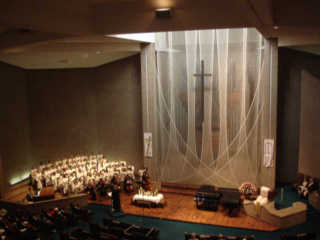|
|
Documentation for Ambisonic Soundscapes in Three Dimensions |

A view from the control room at the First Baptist Church
|
Recording at the West Mall on the UT campus is a regular
event for Radio-Television-Film students with their DV
camera and a boom mic on a pole with a dead rabbit.
My audio recording did not slow the pace either. The mall
is usually filled with students hawking their cause while
others just want to hurry on to class. The activity there
offers excellent possibilities for interesting listening.
The bells atop the 307-foot tower provided a good vertical
soundscape for my project.
|
I have recorded at the First Baptist Church since 1964, and in
the current building since its construction in 1969. Except for
some air handler noise and pump motor vibrations (not unique to
this structure!), it is an exceptional music space. The arrangement
of the choir loft to the left of the sanctuary with the pipe organ
at the back of a 58-foot high clerestory at the center offers
another opportunity to record ambisonically in an intersting space.
The final segment of my presentation exhibited the sanctuary's
sonic characteristics.
In both recording and editing, I have developed data forms to track dates, time, location, microphone used, file names, and file processing information. I am using an updated version of VVMic, a decoder written by fellow Austinite David McGriffy, to translate from ambisonic B-format to surround stem files. For the upper channels, I set the "elevation" control to 40 degrees. I only edit the stem files; in the case of this project, 24 tracks: 3 sets of 4 channels times two elevations; no center front nor LFE channels. After trimming the fore and aft parts of the stems, I lined up each segment stem on its respective final track. Adobe Audition will automatically crossfade segments that overlap, a convenient feature relatively new to Audition. A screen shot of the final tracks and more information follows on the next page. |
DOCUMENTATION - RECORDING - PART 2
|